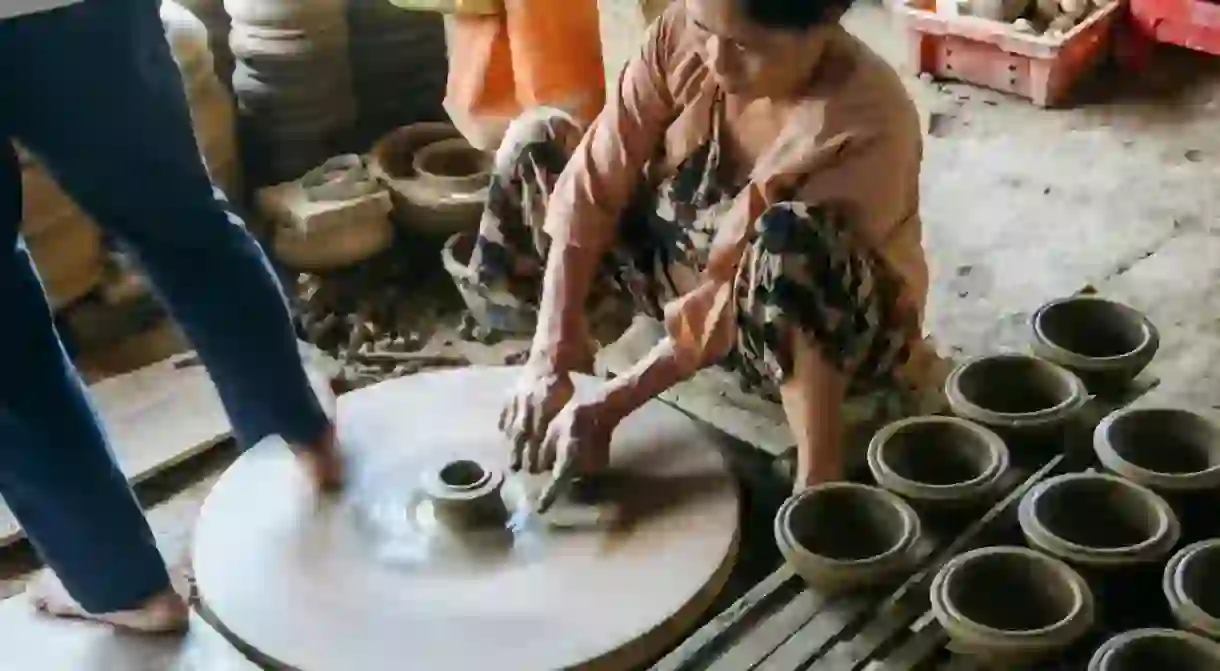Exploring Hoi An, Vietnam's Pottery Village

Pottery to the Vietnamese is not just an art form, but also an important means of livelihood. The Thanh Ha Pottery Village in Hoi An is by far the best example of this.
Thanh Ha Pottery Village has been making beautiful artwork for over 400 years. But it was put on the map during the time of the Nguyen Dynasty, when craftsmen were invited to fashion some decorative articles for the palace. This one-off event granted them sufficient renown to last them a lifetime.

The village is located in the Thanh Ha ward of Quang Nam province, just off one of the tributaries of the Thu Bon River. It is a mere mile (three kilometres) from the Hoi An Ancient Town. The scent of wood burning in the kiln will hit your olfactory senses as you walk through the narrow pathways that form a maze through the villager’s simple riverside homes. You will see all sorts of pottery in various stages of production, stacked sometimes five feet high by the entrances. The craftsmen and women here create all sorts of decorative work and pottery such as cups, jars, bowls, pots and the like.




The first stop is at Mrs. Han’s. When we arrive, she welcomes us to her shop with a pleasant smile and begins chatting as she continues to smooth out the inside of a bowl before it is set to dry. She is wearing a white hoodie and a large hat to protect her skin from the midday sun — it’s scorching hot, and most days in Hoi An are like this. Mrs. Han had inherited the business from her 85-year-old mother-in-law but she is not around. The business is over 60 years old now, and she is the only one in the family creating pottery work. Her children are in the city, doing modern jobs.

Today Mrs. Han is joined by a friend, who is a contracted worker for the shop. Even though it is her nap time, she sits down with us and gives us a demonstration of their work. Old, fragile hands create the perfect curve of the ceramic item with precision, care, and love, while Mrs. Han helps spin the wheel in a rhythmic motion with deft kicks. It’s awe-inspiring.





At Mrs. Han’s shop, you will find all sorts of products made such as jars, containers, piggy banks, and little pottery figures.

Mrs. Thoi welcomed us over to her shop next. Her pottery shop is similar to others in the village, inviting curious tourists and ambitious photographers with the stacks of pots and vases at the entrance.


Mrs. Thoi, like the rest of the craftsmen here, is extremely skilled, and has been making pottery for over 40 years. Right now, she is making incense burners as we chat. She is dressed in a floral ao ba ba, the Vietnamese pyjama you see women wearing often on the streets, and her hair neatly tied in a bun. Once she sits down at the wheel, decades of experience take over, and her hands are firm and steady, moulding the moist clay at will. Mrs. Thoi tells us that she can make around 300 to 400 burners a day. Within a minute, a burner is done.



Nothing is mechanised in the village. All pottery are made manually, using traditional clay mixing, moulding, burning and baking techniques. The clay used to come from the river beds and the rice paddy fields. Farmers would take away the clay in order to level their fields, making them easier to irrigate. Now, the clay comes from Quang Nam, which is about eight miles (12 kilometres) from Hoi An. The items created here are beautiful, durable and are exported around the world. Now, the village is sustained primarily through exports and by tourism.

At our final stop, Mr. Xe greets us with another humble smile. He has been running his shop and creating beautiful pottery products for over 38 years now. While Mr. Xe is mainly cooking and storing products, his son is creating little figurines called to he. These are pottery figures of the 12 animals of the Chinese zodiac calendar. Every day, hundreds of these figurines are made at Mr. Xe’s shop, along with other products like jars, cooking and storing containers, incense burners, and piggy banks.




While his hands are at work, Mr. Xe talks about life in the village. The work here is hard, the income is not high, and the working conditions are rough – during flooding season especially. It can put a shop out of business for a while, leaving owners to survive on any savings they had made before.
Despite the hardships though, they are happy and enjoy what they are doing. They cannot help but smile at the look of awe and surprise on tourists’ faces that visit the village every day. It’s what keeps them going. The craftsmen also love inviting curious tourists over and letting them have a go at making some pots.

Getting to the village is easy. There are many tours offered in Hoi An that plan everything for you. If you wish to go yourself, just follow the main road past the fishing dock of Hoi An Ancient village and you’ll be there in a matter of minutes. The tourists boats will also take you to Thanh Ha Pottery Village.
Spending some time at the village and getting to know the locals are great ways to spend a few hours in Hoi An. Buy some pottery work to take home with you – it will not only add a Vietnamese flare to your home, but will also do these craftsmen a big favour.


Anyone looking for a more in-depth history of ceramics in Hoi An should also visit the Museum of Trade Ceramics, located at 80 Tran Phu Street in Hoi An.













